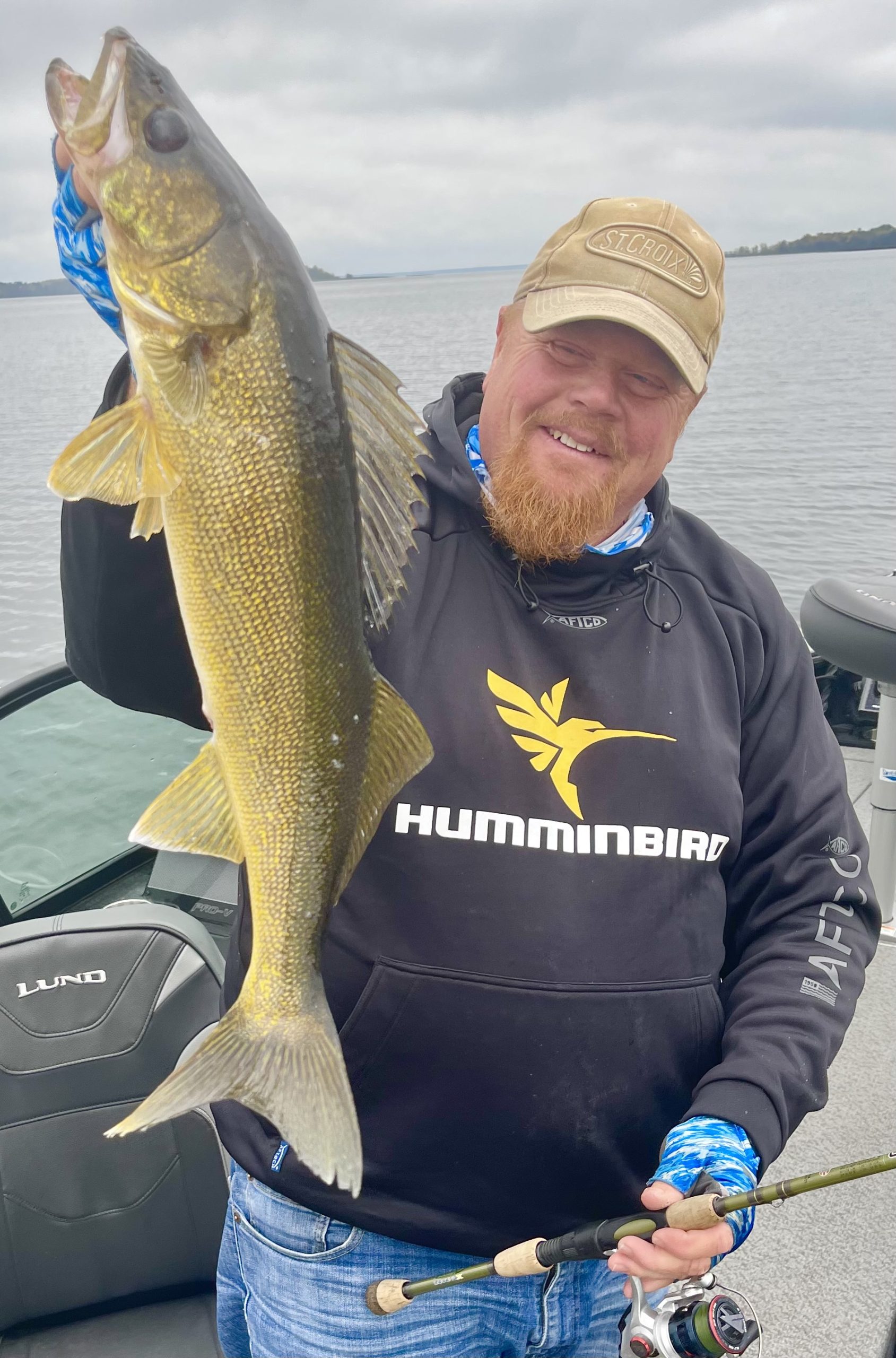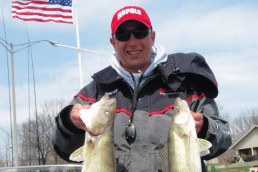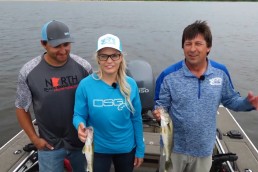Weeds and Flies: Three New Ways to Catch Walleyes
SHARE THIS POST
Weeds grow fast at this time of year. Stable water surface temperature and clear water in early summer allow the sun to reach thriving weed beds. If you miss fishing for several days in a row, the weed beds look completely different your next time out compared to your last time on the water. Vegetation creates oxygen and provides cover for minnows, insects and crayfish.
Green weeds are also some of the best habitats in which to find early summer walleye schools. On stable days, walleyes cruise the edges, hunting or stalking clearings or weed variety changes. Cabbage or milfoil with a patch of Chara in the middle attracts walleyes like padded lawn furniture attracts an uninvited relative. Now you have found a spot where you can consistently catch walleyes. Then one day… they are gone. You catch a few only in early morning and evening, and that’s it.
Nature gives you clues. Just look at the clouds of smoke in the distance. But as you get closer, you notice these clouds are all around the shoreline, plus some in the middle of the lake. These are vertical columns of mosquito-like flying insects. Ah, summer’s first hatch has begun!

Pot of gold
Several insect hatches occur on lakes throughout the summer. In fact, hatches like the mayfly should be called the June and July fly. Hatchlings at 1- to 1 1/2-inch overfeed walleye populations to the point where the fish are unable to eat any more. Walleye bellies are full, throats are full, and their mouths are red and sore. Then the flies emerge from the water, attracted to light-covered decks, docks, porch lights and everything else around the lake. But that’s a different story.
Let’s talk about the midge fly. Midges start as simple bloodworms in the lake’s mud basin, living in their little worm tubes throughout the winter months. They feed on decaying matter drifting from dying weed beds. In fact, they clean up the decaying weed matter like tiny vacuums. These small, red delicious worms support the winter appetite for every species of fish in the lake.
This time of year, bloodworms swim to the surface, shedding their skin and turning into a flying insect. They assemble in vertical, smoke-like columns, living three to five days in the air, consuming nectar, mating and dropping their sinking eggs back to the mud.
Large hatches bring big schools of “eater” walleyes to precise locations adjacent to the lake’s muddy basin. I have found enormous schools of 15- to 18-inch walleyes around these hatch areas. You will know when you’re close; your boat will be covered with harmless little black bugs that are squishy and easily flatten to a tiny ink stain on your clothing, boat and sunglasses, and splatter on your hat and face. Can’t miss it! (My Lund’s full windshield saves my client’s faces and clothing.)
These areas are not far from the lake’s weed beds—usually near a steep drop-off and a windbreak area where fragile bugs can hang out together. I highlight the contours on the LakeMaster map on my Humminbird SOLIX. Shading the weed beds in a lighter green color and compared to deeper-water blue really narrows down the chase. I use Side Imaging to look for the big school of eater walleyes. Don’t be surprised when you find these areas holding walleyes year after year around that time.
Bro tip: Electronics are important for finding fish, and using multiple electronics sucks a lot of juice from your batteries. Don’t run your sonar or other machines off your starting battery. Have a dedicated battery for your electronics. I use Amped Outdoors lithium batteries for my electronics and trolling motor. Side Imaging and Forward Mode will show more detail and last longer. Choose 12-volt, 100- or 160-amp-hour batteries depending on the number of graphs and sizes. I use two 36-volt trolling motor batteries, specially designed for trolling motors with heavier gauge wiring.

Match the hatch
From opening day of the walleye season to the midge fly hatch, using a spottail shiner on a Northland Fishing Tackle Tungsten jig is automatic for enticing and catching shallow- to mid-depth walleyes. However, spottail shiners are more difficult to find by summer; shiners have spawned, left for deeper depths and bait shops run out. Walleyes slightly reluctant to drop into deeper depths have turned their sights to the delicious little black worms with wings that are billowing out of the bottom. To walleyes, midge flies are like popcorn to people; you can eat but never get full. That’s why the midge fly hatch is a positive hatch. It schools up loads of walleyes and doesn’t fill them up!
Time to try something different
I have an assortment of rods tied with a three-pronged approach for when I find schools of walleyes this time of year.
1. Northland Lite-Bite Bobber with 1/8-ounce Northland Tungsten Jig, baited with a half ‘crawler or fluffy leech. I spot the fish on my Humminbird MEGA Live and pitch past the walleyes with my bobber rig, then pull my presentation slowly up to the fish.
2. On windy days, the bobber blows away too fast, so I use my Drop Shot Stealth Rig. I walk it right up to the fish, keeping my fishing rod elevated and the drop shot weight size at 1/4- to 3/8-ounce, depending on wind speed.
3. One of my favorites is Northland’s Eye Candy Jig Crawler on a Tungsten long- or short-shank jig. The Eye Candy Jig Crawler is different from anything I have ever used. When you pause your jigging stroke, the tail floats up, giving it life. I soak my Eye Candy Jig Crawlers with fish scent such as Pro-Cure or Dr. Juice. When experimenting, only add scent to one or two tails at a time until you find a scent they love. (I found out the hard way what happens if you choose one the fish don’t like!) Let them marinate before your fishing trip, soaking up the scent so it stays on the tail. Try different jig and tail colors until you find the hot combo. One of my best colors on a gin-clear body of water is a sunrise jig with a purple chartreuse tail and black jig head. A black tail was a close second.
Are you enjoying this post?
You can be among the first to get the latest info on where to go, what to use and how to use it!
Bro tip: Short-shank jigs gives the jigging crawler more flexibility and more movement. Be sure to try it!
The setup
1. For my slip bobber setup, I use a St. Croix Avid 7’1” medium-fast spinning rod with a Seviin GX2000 reel spooled with 10-pound-test Sunline 10 SX-1 green braid. Tie in a one-inch Northland Lite-Bite Bobber—it has brass grommet for use with braid—to a size 8 brass or tungsten sinker and a swivel, with three to four feet of Sunline FC fluorocarbon leader and a 1/16-ounce Tungsten jig head.
2. For the drop shot rod, you need backbone with a sensitive tip. That’s St. Croix Avid 7’3” medium-light, extra-fast rod and Seviin GX200 reel spooled with 10-pound Sunline SX-1 green braid, using a back-to-back uni knot to a 10-pound Sunline FC fluorocarbon leader with a 1/4-ounce tungsten sinker. At the bottom, tie a loop of line at the distance walleyes are holding off bottom. For example, if the walleyes are four feet off the bottom, the loop is four feet above the sinker. Add a #4 Gamakatsu hook and colored bead on the live bait loop. Pssst…this is Bro’s Stealth Rig!
3. My pitching combo is a 6’10” St. Croix medium-extra-fast rod with a Seviin GX1000 spooled with Sunline Super Natural mono or braid, with three to four feet of Sunline 8-pound FC fluorocarbon leader and a 1/8- to 1/4-ounce Northland Eye Candy Jig Crawler.
Day bites
Walleye activity ramps up in the evenings near sunset; however, I’m a big fan of fishing during the daylight hours where I’m able to keep an eye on other boating traffic. And some really good patterns emerge for the day bite.
Prepare ahead of time for ways to keep your boat where you need it to stay. I have a Minn Kota Ultrex trolling motor with Spot-Lock to anchor up- or downwind of the walleye school in the windiest conditions. I’m looking forward to using Minn Kota’s Quest series trolling motor which is very quiet and efficient with big torque. On calm days, I love to use my 15-foot Talon shallow-water anchors to hold near walleye schools without sound or turbulence. I have two Talons so that I don’t spin in a circle on variable windy days. The days of dropping huge lead anchors, letting out rope and repeating are gone. Now we can just push a button and Minn Kota keeps us there for as long as needed.
Pitch at the fish, try my three-pronged approach, grab some Northland Tungsten jigs and Eye Candy—and for added insurance, never go without the walleye’s three food groups: leeches, ‘crawlers and minnows. Yes, this adds a little more expense, but it’s a more important purchase then wasabi nuts and energy drinks.
Bro tip: Mother Nature is moody. Dress for the sun and rain. I use Fish Monkey Stubby Gloves and Face Guards to protect myself from the sun—and also miscast jig hooks. Sunscreen on your fingers kills live bait and deters walleye bites, so I like these alternatives for my face and hands. For rainwear, I choose the AFTCO Barricade bib and jacket.
Final thought
I’ll leave you with this parting story. I used a Northland Tungsten Jig and Jig Crawler for the last 14 days on guide trips. I retied after northern pike frayed the line, but the jig worked the entire time. Some days, we had to switch to a bobber. Other days, it was the stealth rig, but it didn’t shrink much at all hooked on the lure keeper on my St. Croix rod. It was out in the weather and water every day until a small hammer-handle pike bit my line and swam away with it.
Outdoor communicator Brian “Bro” Brosdahl lives in northern Minnesota and is a walleye guide in the Cass Lake, Leech Lake and Lake Winnibigoshish areas. Bro is a four-season fisherman and is especially known for his ice fishing knowledge and skills. For guide inquiries, contact: brosguideservice.com.
MWO
SHARE THIS POST
Did you enjoy this post?
You can be among the first to get the latest info on where to go, what to use and how to use it!
Brian 'Bro' Brosdahl
Outdoor communicator Brian “Bro” Brosdahl lives in northern Minnesota. He is a walleye guide in the Cass Lake, Leech Lake and Lake Winnibigoshish areas. He is sponsored by Northland Fishing Tackle, Frabill/Plano, Aqua-Vu, Humminbird/Minn Kota, St. Croix Rods, Ranger Boats, and Evinrude. Guide inquiries: brosguideservice.com. Follow on social media.



